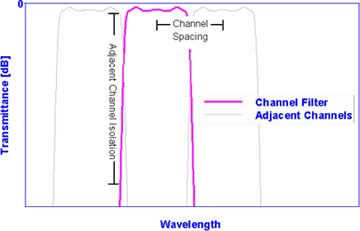A simple approach in optical data communication is the use of a pair of optical fibers for a single channel transmission. The fiber pair provides the two directions for transmitting the data. Basically, one pair of fiber is equivalent to one data channel and the light coupled into the fiber, no matter what wavelength, is the optical carrier signal for data transmission.
Channeling data in WDM
However, in modern fiber-optic communications, not one but many optical channels are transmitted via a single optical fiber. This approach is based on wavelength division multiplexing (WDM). Here, one fiber is not limited to one channel any more but multiple optical signals are transferred onto a single optical fiber by means of multiple WDM channels. A WDM channel is therefore assigned to a specific frequency or wavelength within the optical frequency or wavelength domain that is sent through the optical fiber. Different WDM channels are separated by a defined difference in frequency or wavelength, which is the channel spacing. Hence, the principle behind WDM is, that all WDM channels are multiplexed into a single optical fiber at the transmission end and demultiplexed again into different channels at the receiving end.
More WDM Channels increase Network Bandwidth
To increase the bandwidth of a fiber-optical network, it makes sense to first increase the number of optical channels rather than install more cables, which is usually associated with much higher costs. As each WDM channel represents a wavelength, the WDM channel spacing has to be reduced to fit more wavelengths within a certain domain window. However, the minimum frequency or wavelength spacing is limited and is actually dependant on many factors such as inter-channel crosstalk, signal degradation, filter quality, laser wavelength stability, data rate, transmission length and more.
The common types of WDM are (normal) WDM, coarse WDM (CDWM) and dense WDM (DWDM). Their main difference is the possible number of WDM channels. Basic WDM only supports two channels. One in the 1310 nm and one in the 1550 region (sometimes 850 nm and 1310 nm). Coarse WDM already supports up to 18 channels at most between 1271 nm and 1611 nm wavelength and dense WDM increases up to 80 channels with 0.4 nm wavelength channel spacing in the most common use or even more channels. In principle, hundreds of channels are possible in future developments and applications.
Managing WDM Channels
Multiplexing and de-multiplexing specific WDM channels is crucial in optical networks based on WDM, CWDM or DWDM. Telecom filters are the most common components to multiplex and de-multiplex wavelength signals for single band or even multi-band separation. A WDM channel filter can separate a channel from a wavelength domain or also add a channel to a group of others. It basically transmits a WDM channel while blocking the others. Besides filtering one WDM channel, channel splitters for example filter full channel groups from a wavelength domain instead of a single WDM channel.
Iridian provides standard CWDM and DWDM high quality telecom filters at competitive prices in a large variety of filter types from single band to multi-channel separation filters in form of bandpass and edge filters. Further, we offer custom-made filter solutions to meet individual demands in fiber-optical networks. For custom requirements and quotes for our Telecom filters, click here.



